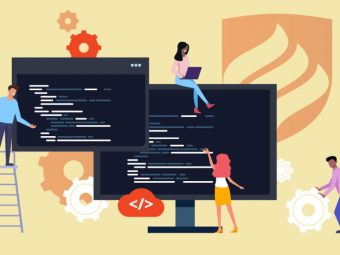Data Integration Fundamentals
Tags: Database Management
Learn how to use data integration techniques to optimize business results and supercharge your career
Last updated 2022-01-10 | 4.3
- Data integration basics - What is data integration and why it's important in the modern business environment- How data integration skills can create more success in your non-technical career
- Why data integration is a great way to transition into a technology career
What you'll learn
* Requirements
* No experience with databases or programming is necessary to benefit from this course.Description
It’s clear that we are living in a data-driven world. Our steady transition toward highly digitized lives is making data a key asset in the modern economy. When we go online to make purchases, consume content, or share on social media, we are generating valuable data. Many of the largest tech companies are now operating on business models that depend on leveraging data. However none of that is possible without data integration. Data integration is the glue that makes it possible to convert raw data into a valuable asset.
In this course, I will focus on three types of data integration: Business-to-Business Integration, Application Integration, and Database Integration. You will learn how businesses exchange data using standard EDI, XML, and APIs. I’ll explain common communication methods like FTP and AS2. You’ll also learn about application integration approaches including SOAP, REST APIs, and Webhooks. And I’ll teach you about database integration technologies involving data warehouses, data lakes, streaming data, extract-transform-load processing, and data propagation techniques like replication.
By the end of the course, you’ll have a solid understanding of how data integration can be used to improve business results. You will be knowledgeable about how these techniques are applied, and will be able to intelligently speak with software vendors, customers, suppliers or your internal IT department about data integration projects.
Who this course is for:
- If you are currently working in a technology job, this course will help you be more effective in your current role and give you the skills necessary to participate in data integration projects. If you are not currently working in an IT role, this course will give you knowledge that will set you apart from other workers in your field. Whether you work in finance, marketing, logistics, customer service, or human resources, this course will give you the knowledge to identify scenarios were data integration can optimize business results.
Course content
7 sections • 27 lectures
Course Introduction Preview 03:45
About Your Instructor Preview 03:20
What's Data Integration and Why is it Important? Preview 12:31
Learn how data integration supports software implementations, automation projects, and digitization initiatives.
Data Integration in the Workplace Preview 00:52
Data Integration for Non-Technical Jobs Preview 04:37
Not a tech worker? How data integration skills can help you thrive in your job.
Data Integration for Tech Jobs Preview 03:08
How data integration can supercharge your tech career, or help you get started in IT.
Introduction to B2B Integration Preview 02:45
Electronic Data Interchange (EDI) Preview 16:19
Learn about the structure of ANSI X12 EDI messages, functional acknowledgements, and common EDI messages used for commerce.
XML Preview 08:30
XML is frequently used for B2B integrations. Learn about XML message structure, namespaces, and XML schema. Also covered are XML-based B2B standards like RosettaNet and HL7.
JSON Preview 05:32
Learn about JSON, one of the most popular formats used to exchange data on the web.
Text Files Preview 11:37
Learn about text delimited files like CSV, fixed width files, and how to handle hierarchical data in text files.
Transmission Protocols Preview 11:22
Learn commonly used transmission protocols for B2B messaging including FTP, HTTP, and AS2.
The B2B Implementation Process Preview 16:07
Learn the common implementation steps that are necessary to bring a new B2B interchange into production.
Introduction to Application Integration Preview 07:16
HTTP Preview 12:53
A detailed review of the HTTP protocol including query strings, headers, methods, content types, response codes, and authentication.
SOAP Preview 08:30
SOAP or Simple Object Access Protocol was one of the first HTTP-based integration protocols to gain significant popularity. Learn the mechanics of SOAP and how SOAP messages are structured.
REST APIs Preview 20:44
REST APIs are the most popular method of integrating web-based software applications. Learn about the architectural principles of REST, and see how to interact with the Shopify REST API. Rate limiting and CORS is also covered.
Webhooks Preview 03:39
How to use webhooks to receive data from SaaS products on an event-driven basis.
Other Application Integration Protocols Preview 05:13
A review of additional application integration protocols including GraphQL, OData, and gRPC.
APIs versus EDI Preview 08:13
A comparison of two approaches to integration: APIs and EDI.
Introduction to Database Integration Preview 02:11
A review of the key database integration categories: Data Consolidation, Data Warehousing, Data Propagation, Data Virtualization, and Data Federation.
Data Warehousing Preview 04:56
Learn about the difference between OLTP and OLAP database workloads, as well as how star schemas and columnar databases are used to support descriptive analytics. Also learn about data lakes and how they compare to a data warehouse.
Extract-Transform-Load (ETL) Preview 06:08
Learn about the Extract-Transform-Load (ETL) process which builds data pipelines to load analytics platforms like data warehouses or cloud business intelligence tools.
Batch vs Streaming Preview 02:26
A comparison batch and streaming analytics, and how they affect related ETL processes.
ETL Tools Preview 03:37
A review of some of the most popular ETL tools.
Data Propagation Preview 02:45
Learn how data propagation techniques are used to support analytics, edge computing, and disaster recovery.
Tech Career Resources Preview 00:45
I've provided 3 articles I've written about tech careers and how to make a transition into technology.








 This course includes:
This course includes:















